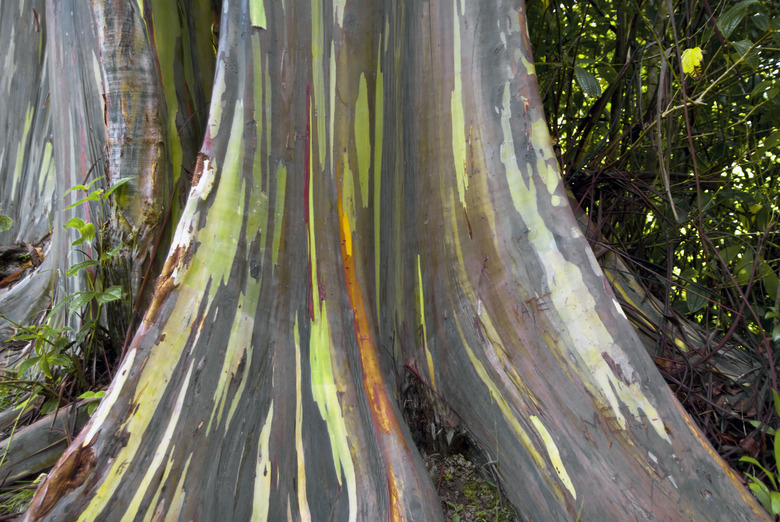Rainbow Eucalyptus Facts
The rainbow eucalyptus tree, also called Mindanao gum (Eucalyptus deglupta), is native to tropical Indonesia, the Philippines, South America, Central America and the Caribbean and is hardy in U.S. Department of Agriculture plant hardiness zones 10 through 11. Although this tree isn't as fragrant as other Eucalyptus varieties, it makes up for its subtle aroma with its colorful trunk. Understanding the tree's growth habits and basic needs can make a rainbow eucalyptus a low-maintenance addition to your landscape.
Basic Attributes
Rainbow eucalyptus is best suited to a large landscape area because it can reach 65 to 125 feet tall outside its native tropical habitat. The tree also has a 60 foot or larger spread, which provides shade and evergreen foliage. Colorful bark makes the tree stand out in the landscape. The smooth, orange bark peels back in summer and reveals green, red, orange and purple coloring. The bark may not develop its full range of colors outside a tropical zone. The tree's fragrant leaves also add interest to the yard.
Site Selection
A location with evenly moist loam provides the best growing location for a rainbow eucalyptus. Overly dry soil can stunt growth or result in death, especially for a young tree. A planting spot near a pond or stream provides adequate moisture. Plant the tree in an area at least 60 feet from buildings, power lines, roads and other large plants so it has room to spread. A rainbow eucalyptus can live up to 150 years and grow 36 or more inches annually. So proper site selection before planting the tree is necessary.
Simple Care
Water is the main concern with this low-maintenance tree. When in an area with a high rainfall total or near a pond or stream, the rainbow eucalyptus rarely requires watering because its soil doesn't dry out. If your rainbow eucalyptus is in a drier location, then water the site when soil begins to dry around the tree's roots. Monitoring the soil with a moisture meter and watering when necessary will help you ensure the soil remains moist to wet around the tree's roots. Beyond watering, rainbow eucalyptus doesn't require regular maintenance to remain healthy.
Few Concerns
Few diseases or pests affect the rainbow eucalyptus. It can't tolerate more than the briefest freeze, however, with even brief exposure to temperatures below 24 degrees Fahrenheit damaging or killing the tree. It is resistant to common diseases, including Verticillium wilt and Texas root rot, but it can suffer from other root rot diseases if its soil drains poorly or doesn't provide adequate root aeration. Aphids and caterpillars sometimes feed on the foliage, but they don't cause enough damage to cause concern or warrant treatment.
